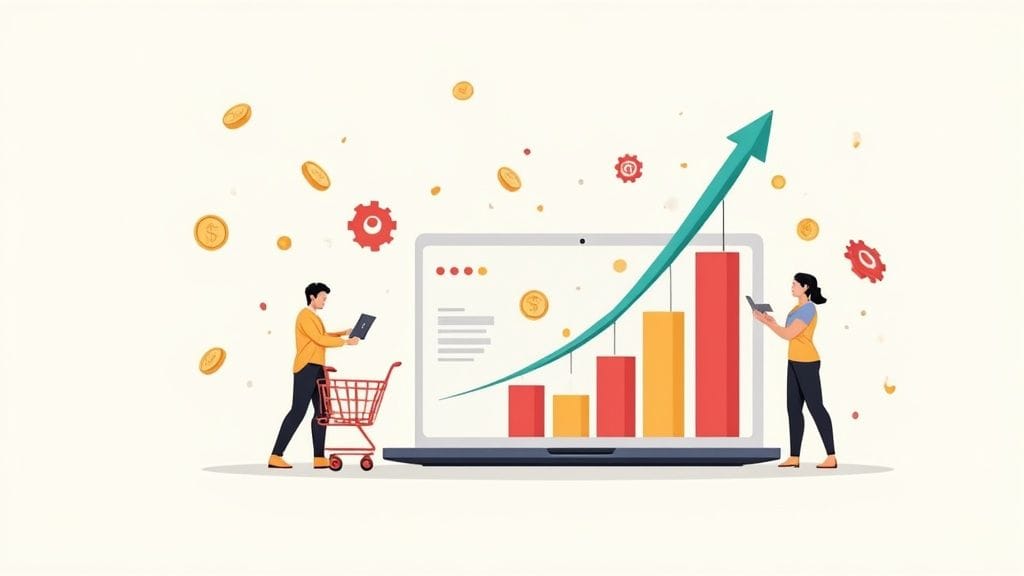If you're looking for a magic bullet to instantly grow your online sales, I've got some bad news. It doesn't exist. Real, sustainable growth isn't about finding a single secret tactic; it’s about a deliberate, multi-faceted approach. Forget the generic advice—let's walk through the specific, actionable roadmap that successful e-commerce stores use every day.
The foundation for driving revenue is built on three core pillars: creating a frictionless customer journey, amplifying your marketing reach, and making data-driven decisions. Lasting growth comes from systematically improving these key areas, turning site visitors into loyal, repeat customers.
Your Foundation for Driving Online Revenue
First, let's zoom out and look at the bigger picture. The e-commerce world is booming, which is both an opportunity and a challenge. Global retail e-commerce sales are expected to jump from $5.09 trillion in 2022 to a staggering $6.42 trillion by 2025. That’s a massive 26.2% increase.
This isn't just a fleeting trend. E-commerce is steadily grabbing a larger slice of the retail pie, projected to grow from 18.5% of total sales in 2022 to 22.5% by 2028. If you want to dive deeper into these numbers, you can find the full e-commerce sales data from Statista.
Setting the Stage with Key Data
Before we get into tactics, it's critical to understand how modern shoppers behave. A few key stats tell a compelling story about where your biggest opportunities (and leaks) are.
Take a look at these numbers. They highlight the exact spots where most online businesses lose money.
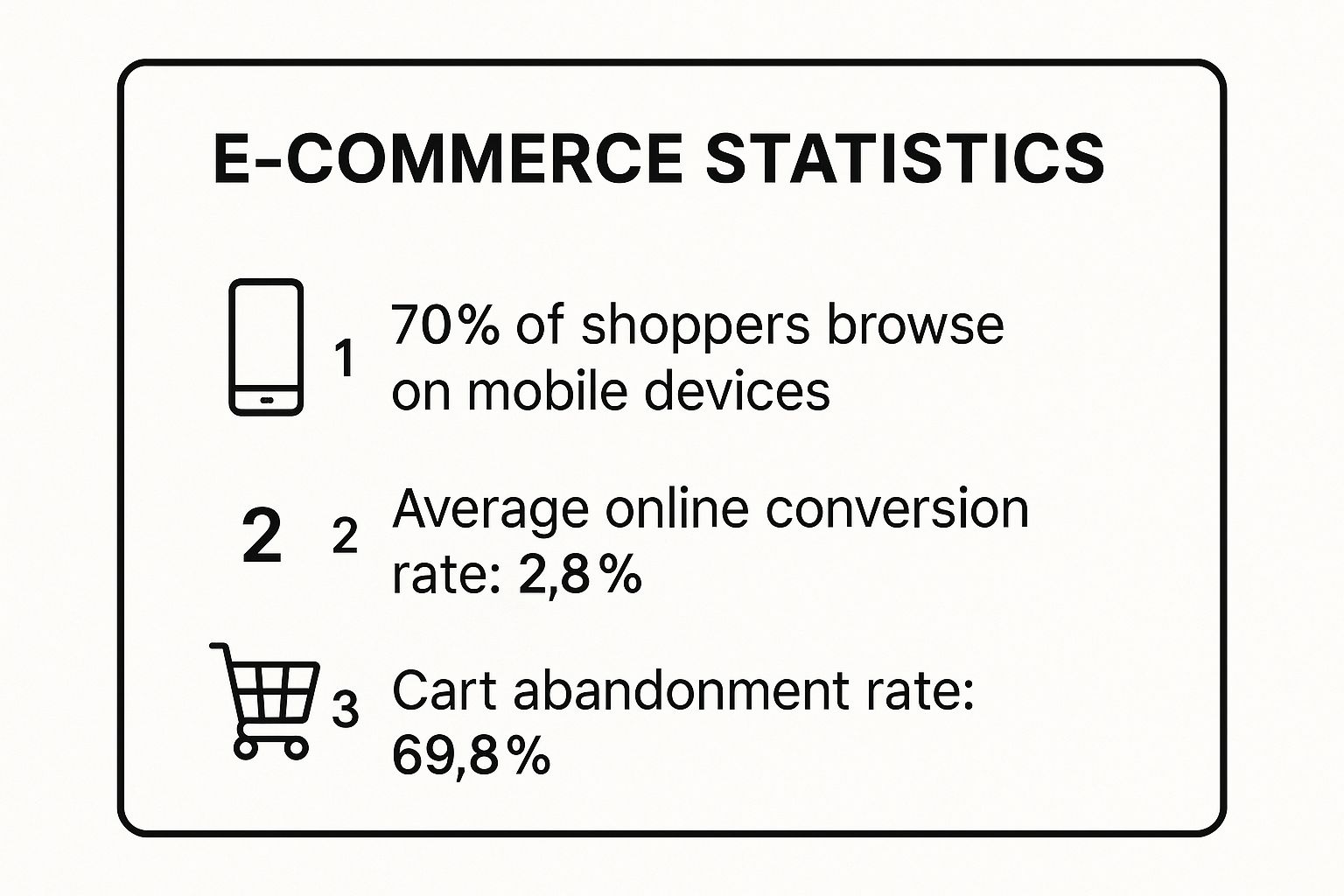
What's the story here? A ton of people browse on their phones, but very few actually buy. And of those who do start to buy, an overwhelming majority leave their carts behind. This is precisely where our work begins—plugging these leaks.
Key Takeaway: The path to higher sales isn't just about driving more traffic. It’s about converting the traffic you already have by optimizing for mobile, streamlining the checkout, and building a trustworthy customer experience.
The Three Pillars of Sales Growth
To build a powerful revenue engine, you need to structure your efforts. I've found it's best to think of your strategy in three fundamental parts, or pillars. Each one tackles a different stage of the customer lifecycle, from their first visit to becoming a repeat buyer.
To make this crystal clear, I've put together a quick summary table that breaks down these core areas.
Core Pillars for Increasing Online Sales
| Pillar | Key Focus Area | Primary Goal |
|---|---|---|
| A Frictionless Customer Journey | Website Optimization & CRO | Make the buying process incredibly smooth and intuitive, from homepage to checkout. |
| Amplified Marketing Reach | Traffic & Lead Generation | Attract qualified customers who are ready to buy through a mix of organic and paid channels. |
| Data-Driven Decisions | Analytics & Insights | Track the right metrics to understand user behavior and continuously refine your strategy. |
Mastering these three pillars creates a flywheel effect. A better website experience improves your marketing ROI, and the data you collect from both helps you make smarter decisions.
Let's quickly touch on what each pillar means in practice:
Pillar 1: A Frictionless Customer Journey
This is all about optimizing every single touchpoint on your website. Think homepage navigation, product pages, and especially that final click at checkout. Your goal is to make buying so easy that your customers don't even have to think about it.Pillar 2: Amplified Marketing Reach
This pillar is focused on getting your products in front of the right people. It combines organic strategies like SEO with targeted paid campaigns and email marketing to attract qualified leads who actually want what you're selling.Pillar 3: Data-Driven Decisions
This is the brains of the operation. It's about tracking the right metrics, digging into your analytics to understand why users behave the way they do, and using those insights to constantly test and improve. No more guessing.
Turn Your Website Into a Conversion Machine
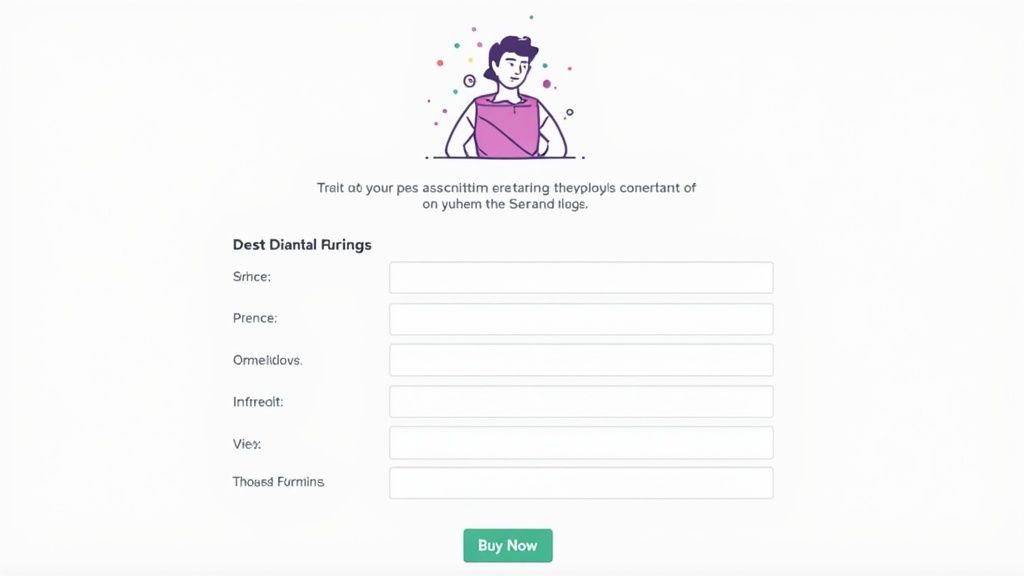
Think of your website as your best salesperson—one that works 24/7 without a break. But if it’s not designed with the customer's journey in mind, it’s like a salesperson who chats up every visitor but never closes a deal. To genuinely boost online sales, you have to transform your site into a well-oiled machine, one that smoothly guides people from their first click to the final purchase.
This entire process boils down to surgically removing friction. Every single element, from your navigation bar to your button colors, either builds trust and encourages a sale or creates confusion and pushes visitors away. The goal is to make the path to buying so intuitive that your customers don't even have to think about it.
Design an Intuitive User Experience
A confusing website is a guaranteed recipe for lost sales. When visitors can't find what they're looking for within seconds, they won't stick around to figure it out. They’ll just leave. This is precisely why a clear, logical navigation structure is so critical.
Your navigation menu is the map to your store. It needs to be simple, predictable, and organized based on how your customers actually think and shop. Use straightforward category names like "Men's T-Shirts" or "Kitchen Appliances," not clever-but-vague marketing jargon. A thoughtful user experience is the foundation of effective website design and a direct driver of conversions.
Here are a few things you can do to improve your site's flow:
- Logical Menus: Group similar products under clear, top-level categories. Sub-menus are great for specific collections, but don't make people click through five levels to find a product.
- A Big, Obvious Search Bar: Make sure your search bar is impossible to miss and, more importantly, returns relevant, accurate results. A smart search function is one of the most powerful sales tools you have.
- Breadcrumbs: Use breadcrumb navigation (e.g., Home > Men > Shoes > Running) on your product and category pages. It helps users easily trace their steps back or explore related areas without getting lost.
Craft Compelling Product Pages
Your product pages are where the real work gets done. This is the moment a visitor decides if your product is the solution they’ve been looking for. Just listing a few features isn’t going to cut it; you have to sell the outcome and build genuine desire.
Start with your visuals. In e-commerce, your photos are your product. Show your items from multiple angles, in different real-world contexts, and include a zoom function so shoppers can inspect the details. A gallery of crisp, professional photos can instantly increase a customer's confidence.
Next, write product descriptions that speak directly to your ideal customer. Don't just list the specs—explain the benefits. Instead of saying, "Made from 100% merino wool," try something like, "Stay warm without the itch, thanks to ultra-soft merino wool that breathes with you."
A great product description anticipates and answers every question a customer might have. It proactively overcomes objections before they even form, which builds a tremendous amount of trust.
Streamline the Checkout Process
The checkout is where most e-commerce stores bleed money. Seriously. Even a tiny bit of friction can convince a shopper to abandon their cart and all the items in it. Shopping cart abandonment rates consistently hover around 70%, which means a massive chunk of potential revenue simply vanishes at the final step. The main culprits? Complicated forms, unexpected costs, and security fears.
Your mission is to make checking out as painless as possible. Here’s how:
- Eliminate Unnecessary Steps: Only ask for information that is absolutely essential to complete the order. Forcing users to create an account is a classic conversion killer, so always offer a guest checkout option.
- Be Transparent with Costs: Nobody likes surprises, especially when it comes to money. Show all costs, including shipping and taxes, right from the start. Surprise fees are the #1 reason for cart abandonment.
- Provide Multiple Payment Options: Cater to everyone by offering credit cards, PayPal, and digital wallets like Apple Pay or Google Pay. The more convenient you make it, the better.
- Display Trust Signals: Show security badges (like from your SSL certificate) and the logos of accepted payment methods. These small visual cues reassure customers that their financial information is safe with you.
Master Mobile Commerce for the Modern Shopper
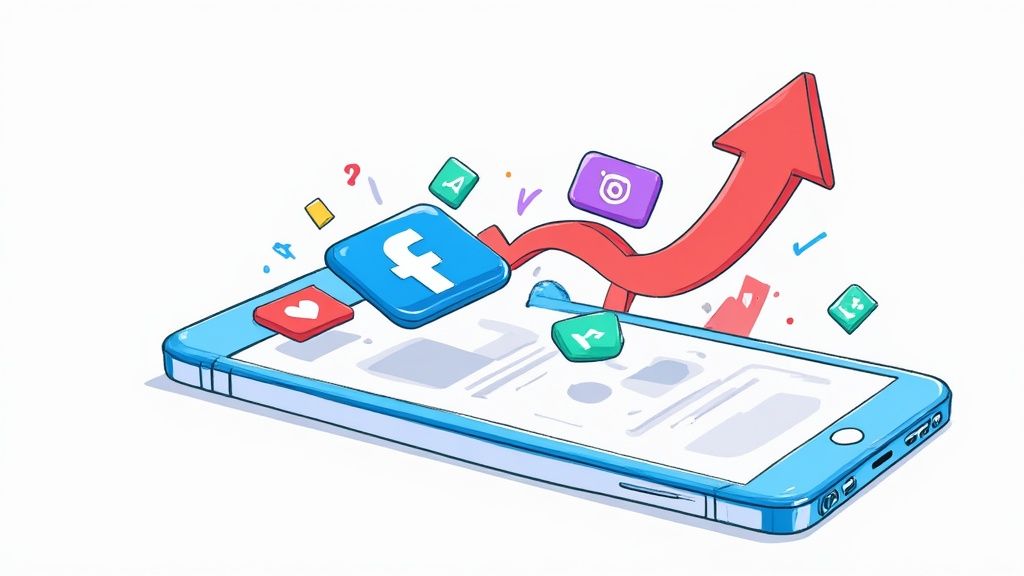
Let's be blunt: if your e-commerce strategy doesn't start with the smallest screen, you’re already falling behind. For a massive chunk of your audience, your mobile site is your brand. It’s no longer good enough to have a desktop site that just shrinks down. You need a truly seamless mobile shopping experience that feels fast, intuitive, and designed for thumbs.
This isn’t just some passing trend; it’s a seismic shift in how people shop. The sheer convenience of smartphones has cemented mobile as a primary driver for growing online sales. Projections show that by 2025, over 70% of all online purchases will happen on a mobile device. Digital wallets? They're already handling more than half of online transactions. For a deeper dive into the numbers, check out these insights on the growth of online and mobile payments from ClearlyPayments.com. The data sends a crystal-clear message to every e-commerce owner.
Prioritize Speed and Simplicity
On mobile, speed is everything. It's not an exaggeration to say that a one-second delay in page load time can tank your conversions by up to 7%. Your mobile site has to be lightning-fast, running on optimized images and lean code that doesn't choke a user's connection. Always think about their context—they could be in line for coffee, relying on spotty cell service. Every single second counts.
Simplicity is the other side of that coin. A cluttered mobile interface is a dead end. You need to prioritize a clean design with ample white space, large and easy-to-tap buttons, and a dead-simple navigation menu. Every element must have a clear job: guide the user toward a purchase without any friction.
Expert Tip: The goal of your mobile site is to remove friction, not add features. Before you add any new element to your mobile view, ask one simple question: "Does this make it faster or easier for someone to buy?" If the answer is no, it doesn't belong there.
One-Tap Payments Are Non-Negotiable
What's one of the biggest deal-breakers at mobile checkout? Forcing someone to manually type in their payment and shipping info. It’s tedious, prone to typos, and a massive cause of cart abandonment. This is why integrating one-tap payment options is one of the single most effective ways to increase online sales from your mobile visitors.
By offering these express checkout methods, you cut down the time to purchase from minutes to mere seconds.
- Apple Pay: Absolutely essential for tapping into the huge user base of iPhones, iPads, and Macs.
- Google Pay: This covers the massive Android market, offering a similarly slick and seamless experience.
- Shop Pay: A fantastic choice for stores on Shopify, as it lets customers use their saved payment and shipping details across the entire network.
Embrace a Mobile-First Design Philosophy
True mobile optimization is more than just a responsive layout. It’s about a complete shift in thinking to a mobile-first design philosophy. This means you design the mobile experience first, perfecting it for the smallest screen, and only then adapt it for larger screens like tablets and desktops.
This approach forces you to distill your user journey down to its absolute essentials, ensuring it's flawless for the majority of your traffic. Once you've nailed that, you can even explore if a dedicated mobile web app makes sense for your business, which can deliver an even richer, more integrated experience right from the browser.
When you master mobile commerce, you aren't just keeping up with a trend. You're future-proofing your business and building an unforgettable brand experience that drives sales and creates loyal customers for years to come.
Expand Your Reach with Strategic Marketing
Look, having a beautiful, optimized website is a fantastic start, but it's only half the battle. If you're serious about learning how to increase online sales, you have to get out there and actively bring the right people to your store. This isn't about just throwing money at ads; it's about building a smart, multi-channel marketing plan that attracts qualified customers without torching your budget. A great product collecting digital dust helps no one.
It’s time to move past the "if you build it, they will come" fantasy. You need to be strategic, placing your brand exactly where your ideal customers are already hanging out. That could be Google, their social media feeds, or their email inbox. A solid marketing strategy ensures you’re grabbing their attention at every single stage of their journey.
Drive Organic Traffic with Smart SEO
Think of Search Engine Optimization (SEO) as your long-term growth engine. It's the art and science of getting your products to the top of Google’s search results when people are actively looking for what you sell. The best part? Clicks from organic search are free, making it one of the most cost-effective ways to build a steady stream of traffic over time.
Good SEO always starts with getting inside your customer's head. What are they actually searching for? Use keyword research tools to uncover the exact phrases they type into Google. Don't just go after broad terms like "running shoes." Dig deeper for long-tail keywords like "best trail running shoes for wide feet." These longer, more specific phrases usually have less competition and are used by people who are much, much closer to pulling out their credit cards.
Once you’ve got your keywords, you need to weave them naturally into your site's fabric:
- Product Titles and Descriptions: Make your product pages impossible to misunderstand and rich with descriptive terms.
- Category Pages: These are perfect for those broader keywords that cover an entire product line.
- Blog Content: Write helpful articles that solve problems or answer common questions related to your products. This is how you become the go-to expert.
Target Ready-to-Buy Customers with PPC
While SEO is a marathon, Pay-Per-Click (PPC) advertising is a sprint. It delivers immediate results. Platforms like Google Ads and Meta Ads (for Facebook & Instagram) let you put your products right in front of hyper-specific audiences. The name of the game with PPC is precision—you want every single dollar you spend to work its tail off.
A great starting point is targeting users on Google based on their search intent. If someone searches for "buy black leather messenger bag," you can show them an ad that links directly to that exact product page on your site. It’s an incredibly powerful way to catch high-intent buyers the very moment they decide they're ready to shop.
On social media, you can get even more granular.
A killer tactic I always recommend is creating lookalike audiences. You can upload a list of your best customers, and the platform’s algorithm will go out and find new people who share similar demographics and online behaviors. It's a fantastic way to discover new, high-quality prospects who are practically pre-qualified to love your products.
Nurture Leads and Drive Repeat Sales with Email
Never underestimate email. It consistently delivers one of the highest ROIs in marketing because it's your direct line to people who have already raised their hands and said, "I'm interested." For any e-commerce store, building a healthy email list should be a top-tier priority.
Give people a compelling reason to sign up. A simple 10% discount on their first order or early access to new arrivals often does the trick. Once they’re on your list, you can build that relationship with valuable content, behind-the-scenes looks, and targeted promotions.
One of the most profitable email strategies you can set up is the abandoned cart sequence. The stats are staggering: roughly 70% of all shopping carts are abandoned. A few well-timed emails can rescue a huge chunk of that otherwise lost revenue. Send a friendly reminder an hour after they leave, maybe followed by an offer for a small discount 24 hours later. That little nudge is often all it takes to get them across the finish line.
Figuring out the right mix of these channels can feel overwhelming. To help you allocate your budget and effort wisely, our guide on how to choose the right digital marketing channels provides a clear, structured approach. A balanced strategy that combines the long-term rewards of SEO, the immediate punch of PPC, and the relationship-building power of email will create a powerful marketing engine that drives sales day in and day out.
Build Lasting Trust and Customer Loyalty
One-time sales are nice, but they don't build an empire. Sustainable growth is built on something far more powerful: customer loyalty. The real goal isn't just to make a sale; it's to create a fan who trusts your brand, keeps coming back, and tells their friends about you. This shift from one-off transactions to genuine relationships is the secret sauce for seriously increasing online sales over the long haul.
But here's the thing: lasting trust isn't built by accident. It’s the direct result of being transparent, reliable, and genuinely helpful at every single touchpoint.
Harness the Power of Social Proof
In the world of e-commerce, your best salespeople aren't on your payroll—they're your existing customers. Social proof, the simple idea that people copy the actions of others, is an incredibly powerful force online. When a potential buyer is hesitating, a wave of positive reviews can be the final push they need to hit "Add to Cart."
Study after study confirms that a staggering 90% of consumers read reviews before making a purchase. If your product pages are ghost towns with zero customer feedback, you're not just missing an opportunity; you're actively creating friction and doubt.
Strategically showing off authentic feedback builds instant credibility.
- Customer Reviews and Ratings: This is non-negotiable. Integrate a review system right on your product pages. Seeing star ratings and reading what real buyers have to say is often the first thing people look for.
- Testimonials: Go a step further than basic reviews. Pull out the most glowing testimonials from your biggest fans and feature them on your homepage or key landing pages. It makes a killer first impression.
- User-Generated Content (UGC): This is the gold standard. Encourage customers to share photos of themselves using your products on social media with a specific hashtag. Featuring this content on your site is one of the most authentic and persuasive forms of social proof imaginable.
The big idea here is simple but profound: let your happy customers do the selling for you. Their unfiltered, honest praise is far more convincing than any marketing copy you could ever write.
Make Your Policies Crystal Clear
Nothing kills trust faster than a surprise shipping fee or a confusing return policy. Shoppers get nervous when they feel like you’re hiding the fine print. This is especially true for shipping and returns—two of the most emotionally charged parts of the entire online shopping experience.
A clear, fair, and easy-to-find returns policy is a massive trust signal. It tells customers that you stand behind your products and that they won't get stuck with something they don't love. For many shoppers, this is a make-or-break factor in their decision to buy from you or a competitor.
Be radically transparent about every part of the deal.
- Shipping: Don't wait until the final checkout page to reveal shipping costs. Display costs and estimated delivery times clearly, early in the process.
- Returns: Create a dedicated returns policy page written in plain English, not legal jargon. Explain the process, the timeframe, and any conditions so anyone can understand it.
This kind of transparency manages expectations and prevents the kind of bad experience that leads to angry support tickets and negative reviews. It’s a sign of respect for your customers, and that’s the foundation of loyalty.
Reward Your Best Customers with a Loyalty Program
It's a well-worn marketing truth: acquiring a new customer costs way more than keeping an existing one. A well-designed loyalty program is your best tool for encouraging repeat business and boosting customer lifetime value (CLV). It gives your customers a concrete reason to choose you again and again.
The trick is to create a program that offers real, tangible value, not just a bunch of meaningless points. What would your customers actually get excited about?
Here are a few ideas for loyalty rewards that work:
- Exclusive Discounts: Give members-only pricing or access to special sales events.
- Early Access: Let your loyal customers be the first to shop new product drops before they go public.
- Free Products: Let points be redeemed for free merchandise. It feels like a real gift.
- Tiered Benefits: Set up different membership levels (think Bronze, Silver, Gold) with increasingly better perks. This gamifies the experience and incentivizes more spending.
A great loyalty program makes your customers feel seen and appreciated, turning them from simple buyers into proud members of your brand community.
Turn Service Into a Sales Driver
Finally, never, ever underestimate the power of outstanding customer service. Every single interaction—whether it’s a live chat, an email, or a DM on Instagram—is a chance to build trust. A fast, helpful, and empathetic response can turn a moment of frustration into a moment of loyalty.
In fact, great service can trigger a powerful psychological effect called the service recovery paradox. This is where a customer who has a problem that gets resolved effectively becomes even more loyal than a customer who never had a problem in the first place.
Why? Because a fantastic service experience proves you care. It shows you're there for them when things go wrong, and that transforms a simple transaction into a real relationship. Those are the customers who become your most powerful brand advocates.
Frequently Asked Gameday Questions About Boosting Online Sales
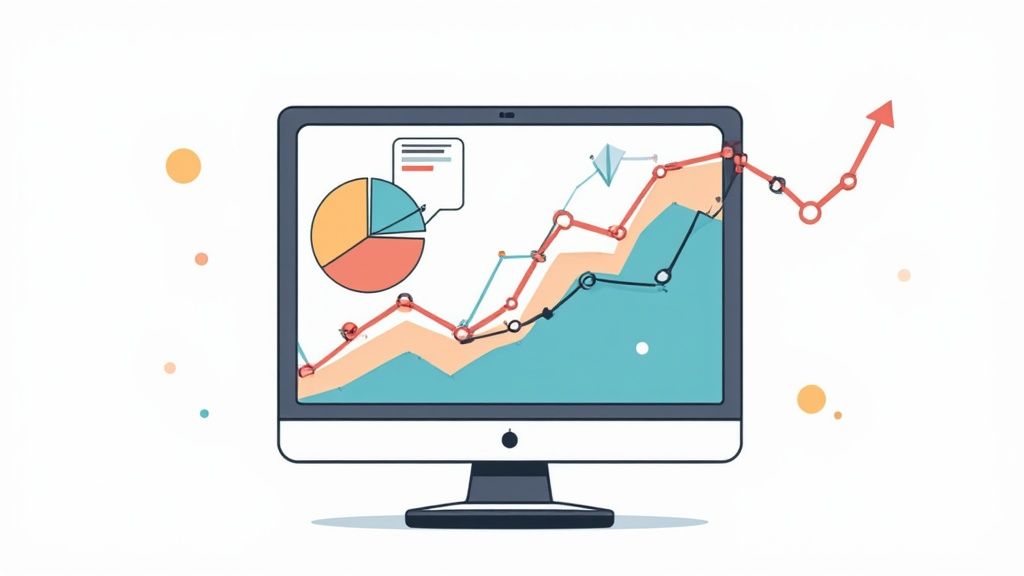
When you're in the trenches of e-commerce, trying to push revenue upward, a lot of questions pop up. It's completely normal. This section is all about giving you direct, no-fluff answers to the most common queries we hear from business owners who are serious about how to increase online sales.
Let's cut through the noise and get straight to the point. Think of this as your quick-reference guide for those moments you need a clear answer, fast.
What Is the Fastest Way to Increase Online Sales?
Everyone wants quick wins. While true, sustainable growth comes from long-term plays like SEO, the most immediate sales injection usually comes from a two-pronged attack: paid ads and conversion rate optimization (CRO).
Kicking off a well-planned PPC campaign on a platform like Google Ads or Meta can bring a flood of high-intent traffic to your doorstep almost overnight. These are people literally searching for what you offer.
At the same time, you need to make sure your site is ready to convert that traffic. High-impact CRO tweaks can make a huge difference in how many of those new visitors actually buy something. Quick wins here include:
- Drastically simplifying your checkout. Every removed field or extra click can save a sale.
- Plastering your site with trust signals like customer reviews, security badges, and clear return policies.
- Sharpening your product page CTAs. Use clear, urgent, and benefit-driven language like "Get Your-s Now" instead of a boring "Add to Cart."
A powerful tactic for a short-term jolt is a flash sale. The urgency you create with a limited-time offer, especially when you push it hard through email and social media, can trigger a massive and immediate spike in revenue.
How Can I Increase Sales Without a Large Marketing Budget?
Bootstrapping your growth is all about being scrappy and focusing on activities with the highest leverage. You don't need a huge budget; you need to be smart.
Your first stop should be your own digital real estate. Double down on on-page SEO. It’s a free way to attract organic traffic from people who are ready to buy. Optimize your product titles, descriptions, and even the alt text on your images with the exact keywords your customers are using.
Next, make social proof your unpaid sales team. Go out of your way to encourage customer reviews and then display them everywhere. It’s one of the most powerful—and totally free—marketing assets you have.
Building an email list is another classic low-cost, high-impact move. Don't just sell to them; engage them. Share behind-the-scenes content, exclusive offers, and helpful tips. You can also get a lot of mileage out of organic social media by creating content that people actually want to share, running fun contests, or even collaborating with micro-influencers who might work with you for free products.
Finally, focus on keeping the customers you already have. It's so much cheaper to get a repeat purchase from a happy customer than to find a new one. Your best retention tool? Seriously good customer service.
Which Metrics Should I Track to Measure Online Sales Growth?
If you're only looking at your total revenue, you're flying blind. To truly understand the health of your business, you need to track the key performance indicators (KPIs) that tell the whole story. These numbers show you what’s working and where your biggest opportunities are hiding.
Here are the vitals you absolutely must monitor:
- Conversion Rate: The percentage of visitors who make a purchase. This is the ultimate report card for your website's effectiveness.
- Average Order Value (AOV): The average amount each customer spends per order. Pushing this number up through tactics like upselling is a direct path to more revenue from the same amount of traffic.
- Customer Lifetime Value (CLV): The total amount you can expect to earn from a single customer over their entire relationship with your brand. This metric tells you if your retention efforts are paying off.
- Shopping Cart Abandonment Rate: The percentage of shoppers who add products to their cart but bail before paying. Reducing this is often the lowest-hanging fruit for boosting sales.
- Traffic-to-Lead Ratio: This tracks how many visitors from different channels (like organic search or social media) become leads by signing up for your newsletter or a freebie.
Watching these metrics gives you a complete dashboard for your e-commerce engine, letting you make smarter, data-backed decisions.
How Important Is Social Proof for Increasing Sales?
Let's be clear: social proof isn't just important. It is critically essential. In today's market, it’s one of the most potent psychological tools you can use. Shoppers are naturally skeptical; they've been burned before. They rely on the experiences of others to validate their own choices.
When you display customer reviews, star ratings, testimonials, and user-generated photos, you build instant trust. It answers the questions every shopper is quietly asking: "Is this product any good?" and "Can I trust this company with my money?"
Just think about your own shopping habits. Are you more likely to buy a product with 50 glowing reviews or an identical one with none? Social proof crushes hesitation, overcomes objections, and provides an authentic stamp of approval that no marketing copy can ever achieve. For any business serious about growth, it's a non-negotiable.
Ready to put these strategies into action? The team at KP Infotech specializes in building high-performance e-commerce websites and running data-driven marketing campaigns that get real results. Let us help you build the powerful digital foundation your business deserves. Learn more about our custom web and marketing solutions.
